Why Seasonal Trends Matter for Dropshipping Products in Fall 2025
Seasonality in e-commerce creates predictable peaks and valleys in consumer demand. Understanding these cyclical sales peaks is “crucial in predicting trends and managing inventory,” enabling you to plan marketing campaigns and stock the right items in time. In other words, what sells in winter (e.g. heated jackets or boots) won’t move in summer, and vice versa. An experienced dropshipper knows to pivot product selection each quarter: for example, CJdropshipping notes that Q3 (summer-to-fall) includes back-to-school and pre-holiday periods, so merchants might start bundling school supplies and fall gear weeks before September arrives. By adjusting your store and ads to seasonal demand spikes, you’ll attract the customers who are actively searching for those items. CJdropshipping sums it up well: “trends are crucial in seasonal dropshipping,” so constantly tracking viral products and audience interests (with tools like Google Trends) helps you align your marketing with what’s hot at the moment.
In practical terms, Fall 2025 means shifting out of summer lines and into cooler-weather and holiday-ready products. Think back-to-school bundles in late summer, early Halloween costume accessories in September, and outdoor gadgets for brisk autumn weather. By anticipating these shifts – say, starting Halloween-themed ads in mid-September – you capture demand early and avoid lagging behind competitors. As we’ll see in the product picks below, each recommended item meets a specific fall-2025 need or trend. Planning ahead for these seasonal transitions is key to dropshipping success.
Fishing Camera
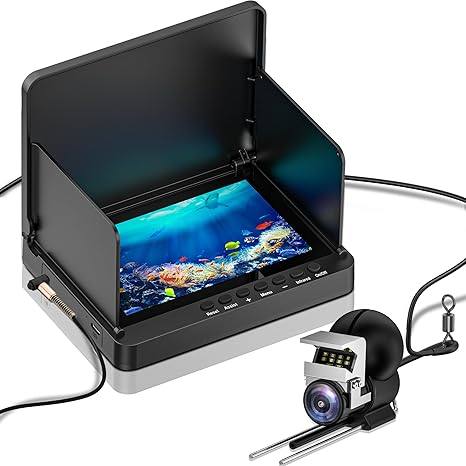
An underwater fishing camera is a high-tech gadget that lets anglers see beneath the surface in real time. These cameras (often with an LED light and waterproof monitor) address the pain point of blind fishing: suddenly buyers can “monitor fish behavior” and target their casts better. SaleHoo’s market report on fishing cameras highlights that this tool is cutting-edge and appeals to both weekend hobbyists and serious anglers. With fall approaching, avid fishermen begin planning next season’s gear, so adding a fishing cam now means you’ll catch early-bird buyers. (SaleHoo even notes that demand peaks in January, so merchants who prep in autumn can capitalize when interest spikes.)
Experienced sellers recommend highlighting the camera’s features in ads – for example, show footage of the LCD screen displaying fish underwater, or a user easily locating a prized catch by sonar. Social ads should target fishing enthusiasts (men 25–55, outdoor hobby groups, boating and camping audiences). Video ads on Facebook or TikTok work great: think POV clips from the camera’s view or a split-screen showing the camera feed and the angler’s smile when they hook a fish. In pricing, these cameras often sell around $77–$170 (average $121). If you source a quality unit for, say, $50–$80 from AliExpress or CJdropshipping, you can mark it up significantly (typical margins can be 40–60%). For example, selling at $120 on a $80 cost yields a 33% margin; selling at $150 on a $90 cost yields 40%. Offering “bundle deals” (camera + extra camera cables or a carrying case) can boost the average order value. In summary: this product meets a real need (improved catch rates) for a well-defined niche (fishing enthusiasts), and fall is the perfect time to test ads before the next fishing season.
-
Ideal Audience: Recreational anglers, boating/fishing club members, outdoor hobbyists. (Often men 25–55, but also gift-givers—fathers, husbands.)
-
Ad Creatives: Underwater footage or demo videos, eye-catching thumbnails of the camera and monitor in use. Emphasize “see underwater, catch more fish.” Run video ads showing a fisherman smiling at his catch, with the camera display onscreen. Use outdoor/nature imagery.
-
Pricing & Margins: Typical sell price $80–$130. Source for ~$50–$80 (e.g. from CJdropshipping or AliExpress). That leaves room for 30–50% profit margins. Consider free shipping to compete.
-
Marketing Strategy: Target Facebook Groups (bass fishing, trout fishing, fishing gear buyers), or use Google Ads on fishing-related search terms. Encourage user reviews: share real “first catch with camera” stories. Seasonal tie-in: pitch as a winter holiday gift for avid fishers.
Warm & Waterproof One-Piece Coat
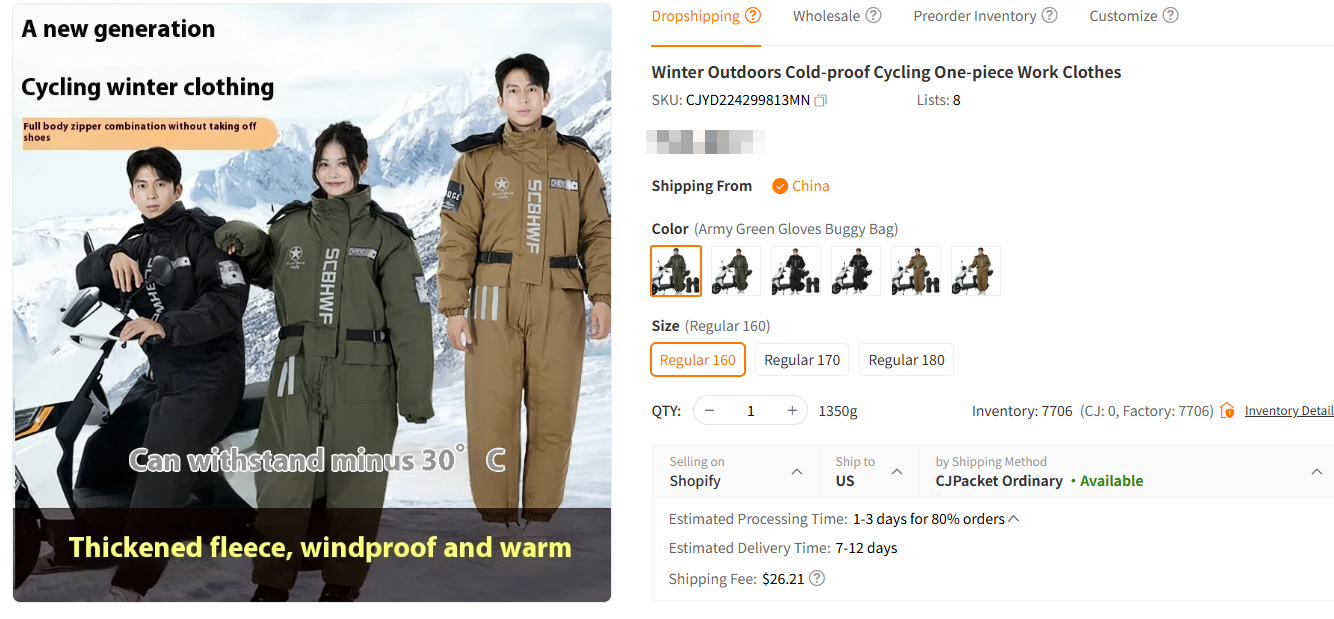
As the weather cools, consumers always start hunting for the latest cold-weather gear. A one-piece waterproof jumpsuit (think insulated ski suit or snowboarding outfit) checks several boxes for fall/winter shoppers. It solves the need for head-to-toe warmth and protection in style. In fact, CJDropshipping’s trend guide explicitly calls out “coats for winter” as seasonal must-haves. A one-piece coat stands out among jackets because it’s novel and eye-catching (customers love matching hats, gloves, and boots to a full jumpsuit). It also appeals broadly: skiers, snowboarders, snow-shoe hikers, or anyone commuting in cold rain/snow.
Why is this good for Fall 2025? Outdoor sports gear is evergreen in winter. Post-pandemic, people also hit mountain resorts again. Social media is full of influencers in chic ski suits. If you drop-ship a fun, waterproof jumpsuit now, you’ll catch early buyers who don’t want their size sold out come December. Plus, fashion trends have leaned toward retro “onesie” styles and bright color-block patterns, making it a shareable product in lifestyle ads.
-
Ideal Audience: Winter sports lovers (skiers, snowboarders), outdoor adventurers, and women ages 18–45 who follow fashion/lifestyle trends. Also consider parents buying for kids or novelty gift seekers.
-
Ad Creatives: Show models having fun in the snow – skiing, skiing down a slope, or building a snowman – all in the suit. Highlight waterproof zippers, insulated lining, and a cozy hood or faux-fur collar. Use video or carousel ads featuring different colors/styles. Seasonally brand it: “Gear up for winter!”
-
Pricing & Margins: Cost on AliExpress/CJ might be ~$35–$45 per suit. Sell on average ~$75–$100. That yields 40–50% gross margins. (Higher-tier thermal ones could sell for $120+.) Take care to advertise slightly higher prices if the suit has real down/insulation.
-
Marketing Strategy: Target Facebook/Instagram ads to ski resorts and outdoor interest groups, or to young women’s fashion audiences interested in outerwear. Partner with winter sports Instagram influencers for styling posts. Offer bundle deals (e.g. coat + matching snow pants) or gift sets (“winter survival kit”). Emphasize urgent winter prep (“Limited stock for fall/snow season”).
Fly Earrings

One of the year’s quirkier trends: insect-themed jewelry. Fly earrings – studs or danglers shaped like realistic flies – have popped up as novelty accessories. They meet a niche want: customers craving unique, conversation-starting pieces. (In fact, fashion blogs note that “insect-inspired jewellery is looming large this season”, with designers from runway to high street using bug motifs.) Fly earrings answer a need for bold, edgy jewelry – whether it’s for a Halloween statement, a party look, or just ironic street style.
Their potential in Fall 2025 is tied to two factors. First, Halloween and the “creepy-cute” aesthetic make bug-themed items suddenly fashionable in early fall. Second, consumers of all ages (from teens on TikTok to mid-aged goth fashion fans) look for novelty gifts and accessories. These earrings are inexpensive to source (many cost just $1–$3 each on AliExpress) but can sell at $10–$20 or more per pair. Their high perceived value and viral potential (imagine a TikTok showing them glowing under blacklight) make them ideal for fun social ads. They stand out in the jewelry market because they’re not everyday minimalism – they solve the need for “something cool and different.”
-
Ideal Audience: Young fashion enthusiasts and Halloween shoppers. Think women (and men) 16–35 who like alternative or quirky jewelry, plus gift-buyers for that crowd. People active on TikTok/Instagram and Etsy-like markets.
-
Ad Creatives: Bold, bright photos of the earrings on a display or model – maybe worn with a corresponding outfit. Create a mini-story: e.g., “Not your average stud.” Add a Halloween spin (“Get ready to buzz around the dance floor!”). Short videos revealing the earrings from a box, or a model turning to reveal the earring detail, can work well.
-
Pricing & Margins: Typical supplier cost ~$1–$4 per pair. Sell them for $12–$18 per pair (many shops price novelty earrings ~$15). That’s ~300% markup. You can even do 2-for-1 deals (sell two pairs for $25) since cost is low.
-
Marketing Strategy: Use visually striking ads on Instagram and TikTok. Target costume/cosplay and fashion accessory hashtags, or run Halloween countdown campaigns in October. Audience interests could include “Halloween parties,” “punk fashion,” or Etsy-style jewelry shoppers. Encourage user-generated posts by asking customers to show off their fly earrings with a catchy hashtag.
Hamster Wheel Car

No image. In the pet toys niche, one of the fun viral toys is a hamster wheel car – basically an exercise wheel shaped like a racing car for small pets. This product addresses a specific need: providing small pets (hamsters, gerbils, etc.) with exercise and enrichment. Instead of a plain plastic wheel, the “car” design turns exercise into play. It’s especially appealing to parents buying for children’s classroom pets or hobbyists who share pet photos online.
From a trend perspective, interactive pet gadgets are in demand. CJ Dropshipping’s trends list highlights “interactive pet toys” as a rising category, like laser pointers and puzzle toys. A hamster wheel car fits right in as a novel pet gadget. It’s not seasonal per se, but it works as a gift item for kids in fall or as a back-to-school classroom pet gear. The item is lightweight and inexpensive, ideal for impulse buys.
-
Ideal Audience: Pet owners (especially kids’ parents, and enthusiasts of small animals), as well as educators with classroom pets. Typically females 20–45 who buy pet accessories, or young children (or their parents) fond of cute pet videos.
-
Ad Creatives: Show a cute hamster (or a cartoon hamster) running in the car with a smile. Video ads are great here – imagine a hamster zooming around a track. Emphasize the fun factor (“Watch your pet zoom!”) and health benefit (exercise). Use bright, playful graphics and possibly children-friendly fonts.
-
Pricing & Margins: Dropship cost is low, perhaps $5–$8 (hobby-level wheels or printed designs). You can sell it for $15–$25. Even at $15 retail on a $7 cost, that’s ~50% margin. Of course, factor in shipping costs, but since it’s small and light, offer free shipping or $1.95 shipping for appeal.
-
Marketing Strategy: Advertise on pet supply platforms and social media. Facebook interest targets: “pet accessories,” “small animals,” or brands like Kaytee. Also consider short Facebook/Instagram video ads (or TikTok) since people love watching funny pet clips. Capitalize on UGC: repost videos of customers’ hamsters in the wheel. If sold before holidays, label it a cute stocking stuffer for kids with pets.
Soothing Sleep Plush
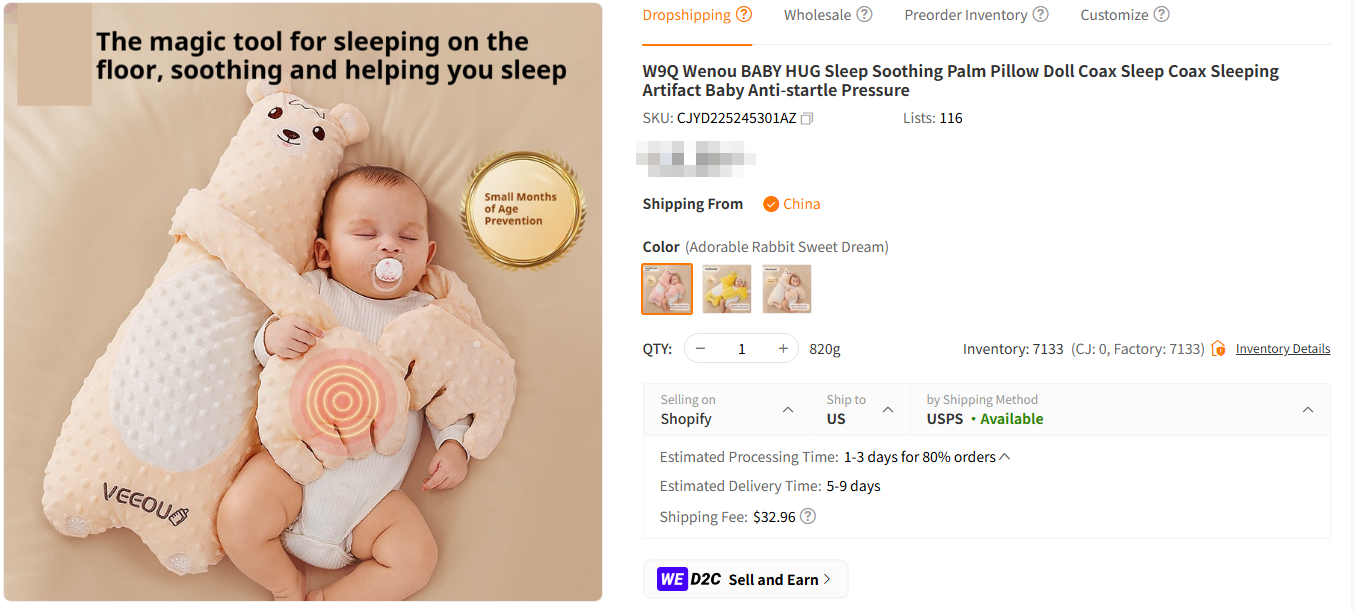
A weighted “sleep plush” toy is a late-2024/early-2025 winning product that perfectly suits fall’s comfort-and-relaxation theme. These are extra-soft stuffed animals (often shaped like bunnies or bears) filled with a weighted pouch to mimic the feeling of a hug. CJ Dropshipping’s trend report praises Sleep Plush toys, noting they “provide an ultra-soft, weighted plush [that] helps anxious sleepers drift off”. In plain terms, it solves a big need: soothing anxiety and improving sleep quality for kids (and even adults). As daylight shortens in fall, products promoting cozy rest are in demand.
This plush has broad appeal – not only do infants and toddlers like cuddly toys, but teens and even stressed college students appreciate a calming companion. The CJ report also highlights that Sleep Plush has a “high perceived value,” allowing 3–4× markups. In practice, if a plush costs you $8–$12 to source, you can sell it for $30–$40. That high margin is a huge advantage. Ad platforms are already buzzing with similar gadgets (weighted blankets, noise machines). The Sleep Plush stands out because it’s tangible and cute.
-
Ideal Audience: Parents of babies/toddlers, anxious teens, and adults who want sleep aids. Focus ads on mothers (25–40) searching for baby sleep solutions, or young adults interested in relaxation products. Also target gift-givers (holidays: “perfect birth or baby shower gift”).
-
Ad Creatives: Show the plush in a peaceful bedroom scene. Use calm, dim lighting and soothing music. Highlight features with text overlays: “Weighted for comfort,” “Easy to clean,” “Helps baby (or you) sleep soundly.” Short TikTok-style videos work well – e.g., a mother giving the plush to a child, who falls asleep cuddling it. As CJ suggests, try unboxing videos or bedtime routine clips. Emphasize trust/safety (mention hypoallergenic fabrics).
-
Pricing & Margins: Typical cost ~$8–$12. Retail around $30–$40. CJ’s analysis explicitly says you can mark these up 3–4× the supplier cost. Aim for ~60–70% margins if possible. To justify price, focus on the luxury feel and therapeutic benefit.
-
Marketing Strategy: Bundle with related items (e.g. “bedtime kit” with a plush + sleep mask or gentle nightlight). Advertise on parenting sites, sleep blogs, or via Google Ads on queries like “help baby sleep.” You could also test Amazon FBA alongside your store for more exposure. Leverage content marketing: share tips on improving children’s sleep on a blog or Facebook page, naturally featuring the plush.
Kids Foldable Outdoor Potty Seat
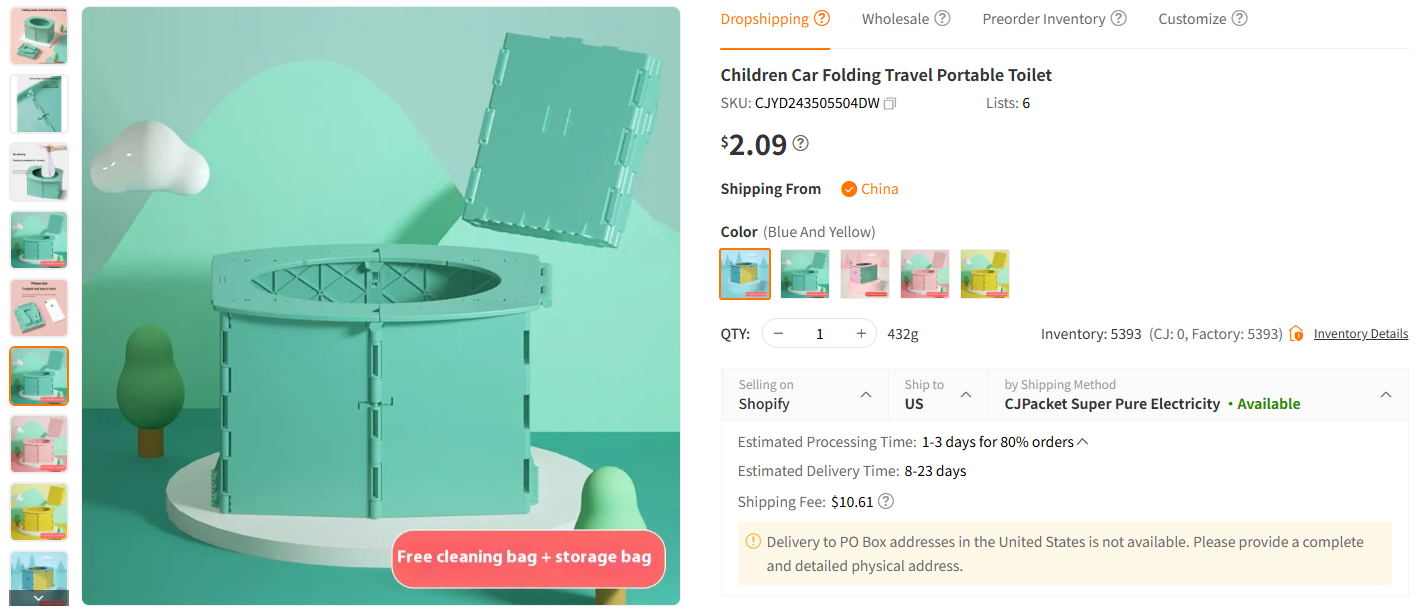
Unlike the other gadgets, a foldable travel potty seat is a pragmatic back-to-school/outing item for parents of toddlers. It’s essentially a collapsible toddler potty with a lid, stored in a bag – perfect for camping, road trips, hikes, or any situation without easy restroom access. As one seller notes, “Our folding travel potty chair is a game-changer for road trips… folds down compactly for easy storage”. In other words, it solves the urgent need of toddlers who say “I have to go NOW” when no bathroom is in sight.
This product’s potential in fall comes from the outdoor-activity and travel angle. Families often take fall camping trips or long drives, and nobody wants a potty emergency at a park. Social posts of smiling kids using a portable potty at a campsite do well. It’s a niche market, but parents will pay ~$25–$30 for convenience. Importantly, this isn’t a product that sits on shelves year-round, so capturing this demand during camping season (late summer into fall) is timely.
-
Ideal Audience: Parents with toddlers (ages 1–4), especially those who like camping, hiking, or road trips. Also useful for grandparents or daycare centers. Mainly moms (25–40) who worry about potty training on the go.
-
Ad Creatives: Show the product in use at a picnic or campground. Emphasize its ease: a quick demo of folding it out and a happy child saying “Ahhh!”. Highlight cleanliness (“comes with disposable liners for mess-free cleanup”). Use bright, family-friendly images.
-
Pricing & Margins: Cost ~ $8–$12 to source from CJdropshipping or Alibaba. Retail on dropship site around $25–$30. That’s roughly 50–60% markup. If the product comes with liners or a small travel bag, you can bundle them and charge a premium.
-
Marketing Strategy: Target parenting forums and travel groups. Facebook/Instagram ads could target “camping with kids” or “mom bloggers.” Write content like “Top 5 road trip essentials for toddlers” linking to the potty seat. During fall, push it as the must-have accessory for weekend campers. Ensure your product page emphasizes portability and hygiene (“folds up small, stores in car”).
Dancing Squid Toy

No image. The dancing/LED squid toy is a viral novelty geared toward babies and toddlers. It’s a sensor-activated toy shaped like an octopus/squid that lights up and wiggles to music when it detects movement. (You may have seen memes of it “dancing” or the “oh see you” trending clip.) This toy addresses the need for baby engagement and tummy-time encouragement: by moving around and playing music, it motivates infants to push up or crawl after it.
Amazon listings describe it as a “hilarious dancing squid” that moves its tentacles, glows with soft lights, and plays cheerful tunes to entertain babies (and even pets). It taps into the booming baby-tech market (think smart toys) and also the gifting market – parents often look for unique baby gifts. In terms of timing, it’s evergreen but see a bump around holiday gift-shopping. Fall marketing can focus on early holiday shoppers.
-
Ideal Audience: New parents or grandparents of infants (0–2 years). Primarily mothers on Facebook parenting pages or early childhood educators. Also people who like novelty tech gadgets for kids.
-
Ad Creatives: A fun video ad is ideal: show the squid sensing a baby, lighting up and dancing, and a baby giggling. Overlay text like “Keeps baby active!” or “Crawling made fun.” Use cute sound effects from the toy’s music. Your visuals should highlight its colorful LEDs and safe, soft design.
-
Pricing & Margins: Dropship cost about $12–$18. A selling price around $25–$35 is common. That yields ~40–50% margin. Emphasize quality/safety (non-toxic plastic, durable). Offer it as “new gift idea” or include it in a baby gift bundle with a small plush or pacifier.
-
Marketing Strategy: Advertise in late Q3/early Q4 as a Christmas gift for babies. Use PPC on Amazon/Google targeting “baby crawling toy” or “cute baby toys.” Consider partnerships with mom influencers for demonstration videos. Highlight its viral appeal (some ads can say “as seen on TikTok!”).
How to Choose the Right Dropshipping Supplier
Picking a solid supplier is critical, especially when demand spikes seasonally. You want reliable shipping, good product quality, and responsive service. Two of the most popular options for dropshippers are CJdropshipping and AliExpress, and another powerful choice is Spocket (for faster US/EU shipping).
-
CJdropshipping: A one-stop solution with warehouses worldwide. CJ provides product sourcing, quality control, and even warehousing, which helps speed up delivery and reliability. They integrate with Shopify, WooCommerce, etc., and have a robust dropship API. Experienced sellers like CJ for its tech tools (real-time inventory sync) and U.S. warehouse stock (for faster shipping).
-
AliExpress: The classic low-cost option. AliExpress has “tons of products” and is the most famous dropshipping marketplace. Virtually any category is available. However, shipping from China can take weeks. To mitigate that, some sellers combine AliExpress with ePacket-eligible items or use Aliexpress’s logistics products.
-
Spocket: A newer player focused on U.S. and EU suppliers. Spocket’s key advantage is speed: about 80% of its suppliers are in the US/EU, so typical delivery is just 2–5 days, compared to 30 days from Asia. Quality control is also higher since Spocket vets suppliers carefully. Spocket offers a curated catalog with branded invoicing, and allows ordering samples easily. If fast shipping and branding matter to you (e.g. holiday rush), Spocket is worth the subscription.
Beyond platform choice, use the following criteria for any supplier: responsive customer service, fast order fulfillment, quality product photos/versions (ideally try a sample order yourself to inspect quality), and good ratings/reviews. Never rely on just one supplier – work with multiple vendors in different regions to prevent stockouts. As AutoDS recommends, having “suppliers in different regions” ensures wider coverage and faster delivery. In practice, you might source some items via AliExpress (for variety) and others via local CJ/Spocket warehouses (for speed). Always double-check supplier delivery times and test order at least one item before launching a product.
-
Platform & Quality: CJ and AliExpress for volume and variety; Spocket for speed (US/EU focus). Check if suppliers offer branded packing or tracking.
-
Shipping: Look for ePacket or warehouse stock for fall products (so orders arrive before late November). Spocket’s 2–5 day shipping can be a competitive edge for holiday shoppers.
-
Communication: Choose suppliers with good English support and quick responses. Test their support by sending pre-sale questions.
-
Integration: Ensure the supplier platform (CJ, AliExpress, Spocket) easily integrates with your store (Shopify, WooCommerce, etc.) for automatic order fulfillment.
Turn September Bestsellers into Sales: Platform-by-Platform CJdropshipping Playbook
Quick note before we begin: the universal goal is the same on every platform — source reliably, list clearly, price for profit, and automate fulfillment. CJdropshipping helps on sourcing, warehousing, branding and fulfillment; your job is store setup, marketing, and customer care.
General prep (do these once, before platform work)
-
Validate winners — confirm demand via Google Trends, ad tests, and social proof.
-
Calculate landed cost = product cost + shipping + transaction fees + expected ad CPA. Target net margin after ads (aim for 25–40% net to start).
-
Order samples from CJ or supplier to test quality and packaging. Don’t launch without a sample.
-
Decide shipping strategy: local CJ warehouses (US/EU) for fast delivery, or China stock for lower product cost. Prefer local warehouses for fall/holiday timing.
-
Prepare clear store policies: shipping times, returns, refunds, contact email. Display delivery windows honestly.
A. Shopify + CJdropshipping — step-by-step
Why Shopify: fastest store setup, best plugin ecosystem, easy to scale with ads.
1. Setup & store basics
-
Create a Shopify store (or use your existing one). Set up payment gateways (Stripe, PayPal), legal pages, and shipping profiles.
-
Create a “Fall Essentials” landing page and banners to highlight September bestsellers.
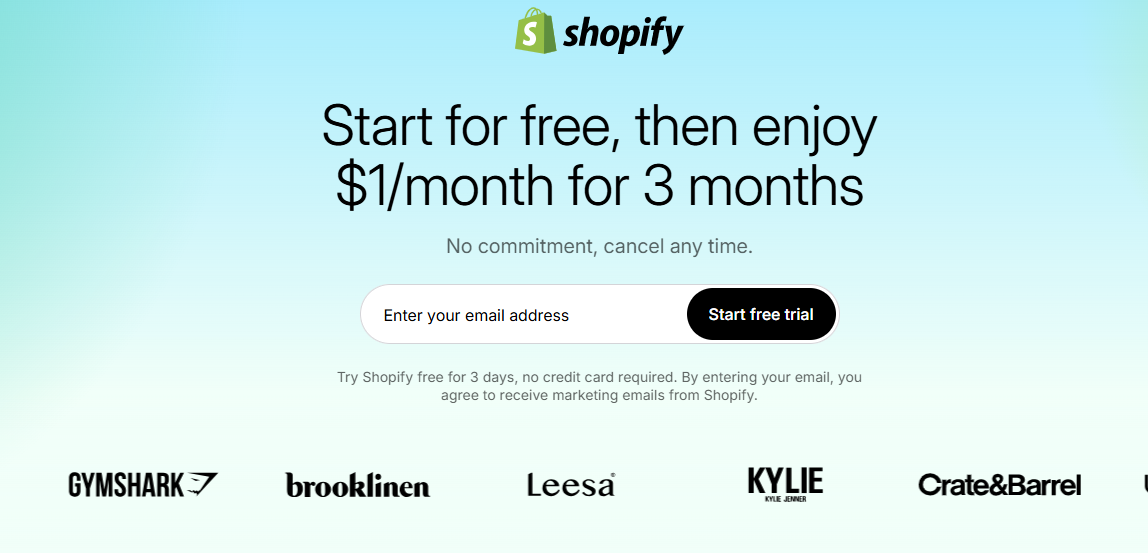
2. Create CJdropshipping account
-
Sign up at CJdropshipping; verify identity. (CJ requires account setup similar to other suppliers.)
-
Browse CJ’s catalog or submit a sourcing request for your chosen SKUs. Ask specifically for US/EU warehouse stock if speed matters.
3. Install CJ integration app
-
From the Shopify App Store, install the CJdropshipping app (or connect via CJ’s integration).
-
Authenticate and link your Shopify store to CJ. Allow product import and order sync permissions.
4. Import products
-
On CJ, find the exact product (or use CJ to source). Import product data to Shopify: title, description, images, SKU, and stock quantity.
-
Edit product pages: rewrite descriptions for SEO, add lifestyle images and 2–3 short demo videos (15–30s). Add shipping and return info.
5. Pricing & shipping profiles
-
Set retail price based on landed cost + target margin. Use dynamic pricing apps if you want auto markups.
-
Create a shipping profile labeled “US Fast (CJ Warehouse)” for items stocked in CJ’s US warehouse; set delivery window 3–7 days and shipping cost (consider free shipping threshold).
-
For China-stock products, set a separate slower shipping profile (7–20 days).
6. Order flow & fulfillment
-
Configure CJ app to auto-fulfill orders placed for CJ products (or manually approve first 10 orders while testing). Ensure tracking numbers are pushed back to Shopify automatically.
-
For branded packaging, request CJ’s custom packaging options and test one sample order. Add branded inserts if budget allows.
7. Testing & launch
-
Place a sample order through your Shopify checkout to confirm the full flow: order goes to CJ, CJ ships, tracking updates your store.
-
Launch lightweight ad campaigns (Meta/TikTok) targeting your audience. Start with $10–20/day per creative, test 3 creatives and two audiences.
8. Scale & optimization
-
When a creative and targeting combination converts, scale budgets and test lookalikes. Use UGC-style creatives showing product in fall scenarios.
-
Monitor CJ inventory, set alerts for low stock, and have a backup supplier SKUs ready.
B. WordPress (WooCommerce) + CJdropshipping — step-by-step
Why WooCommerce: flexible, cheaper monthly cost, good if you like full control.
1. Setup & store basics
-
Install WordPress + WooCommerce on a reliable host. Configure payments, taxes, and shipping zones. Create a fall-focused homepage.
2. CJdropshipping account & connector
-
Sign up at CJdropshipping and request API/ plugin access or use CJ’s WooCommerce integration (CJ provides connectors).
-
Link CJ to your WooCommerce store through the plugin or API keys.
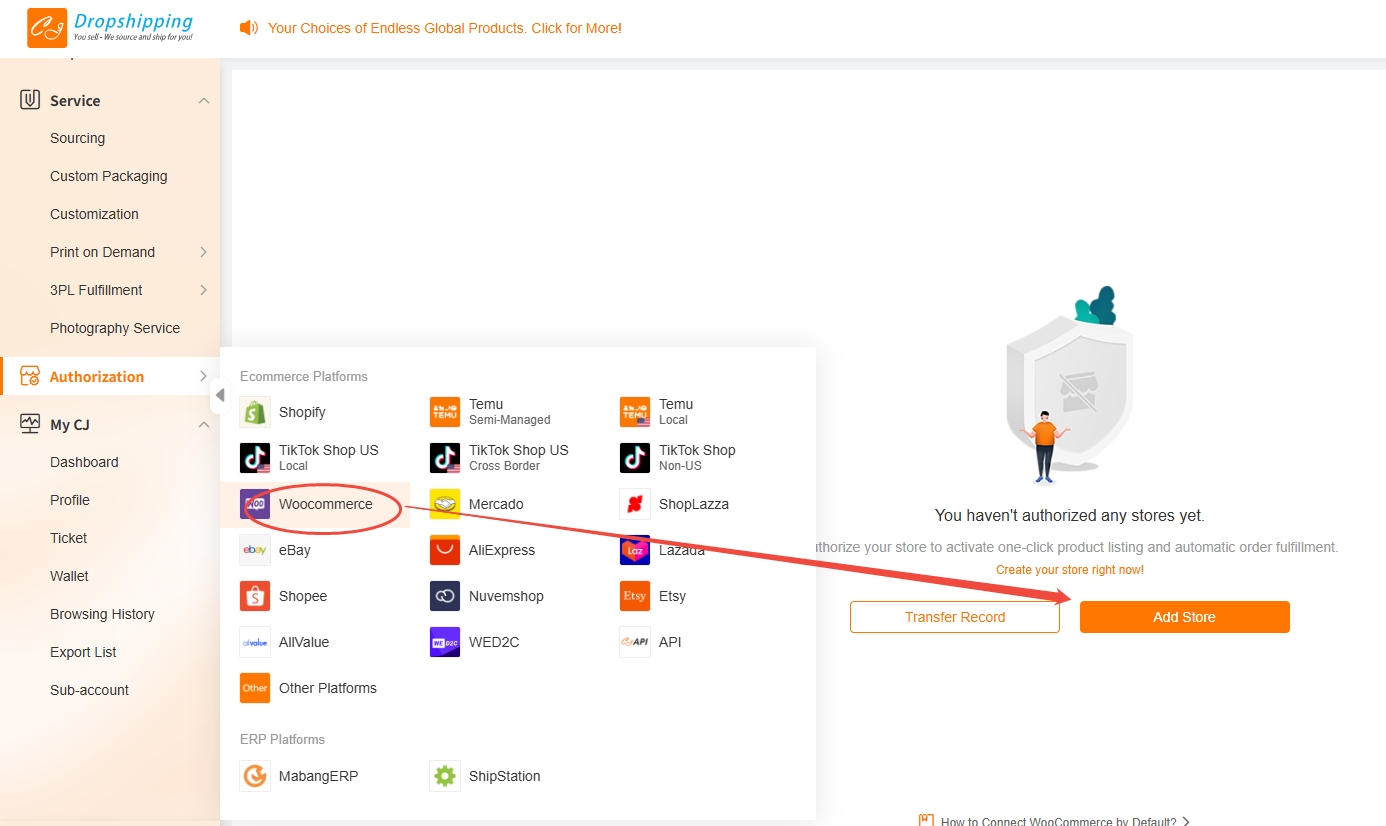
3. Import & optimize products
-
Import products from CJ to WooCommerce. Edit titles, short description (benefit-driven), full description (SEO) and add structured data (schema for product, price, availability).
-
Use image compression and add lifestyle/fall images.
4. Shipping & checkout UX
-
Configure shipping classes: “CJ US Fast” and “CJ Standard Intl.” Show realistic delivery times on product pages. Add one-page checkout optimization to reduce cart abandonment.
5. Fulfillment setup
-
Set CJ to receive orders automatically or configure a daily order import schedule (depending on the plugin). Confirm tracking numbers flow back into WooCommerce and customer emails are sent automatically.
6. Testing & ads
-
Test orders and the return process. Use Google Ads and Facebook; for fall products, run seasonal keywords like “fall coat 2025,” “autumn kids potty seat.”
-
Use email capture popups with “early bird fall discount” campaigns.
C. TikTok — sell via content + TikTok Shop + CJdropshipping
Why TikTok: virality and organic reach; ideal for impulse fall buys.
Two approaches:
-
Drive traffic to your store (Shopify/WooCommerce) using TikTok content and shoppable links.
-
Sell inside TikTok Shop (if available in your region) for in-app checkout and higher conversion.
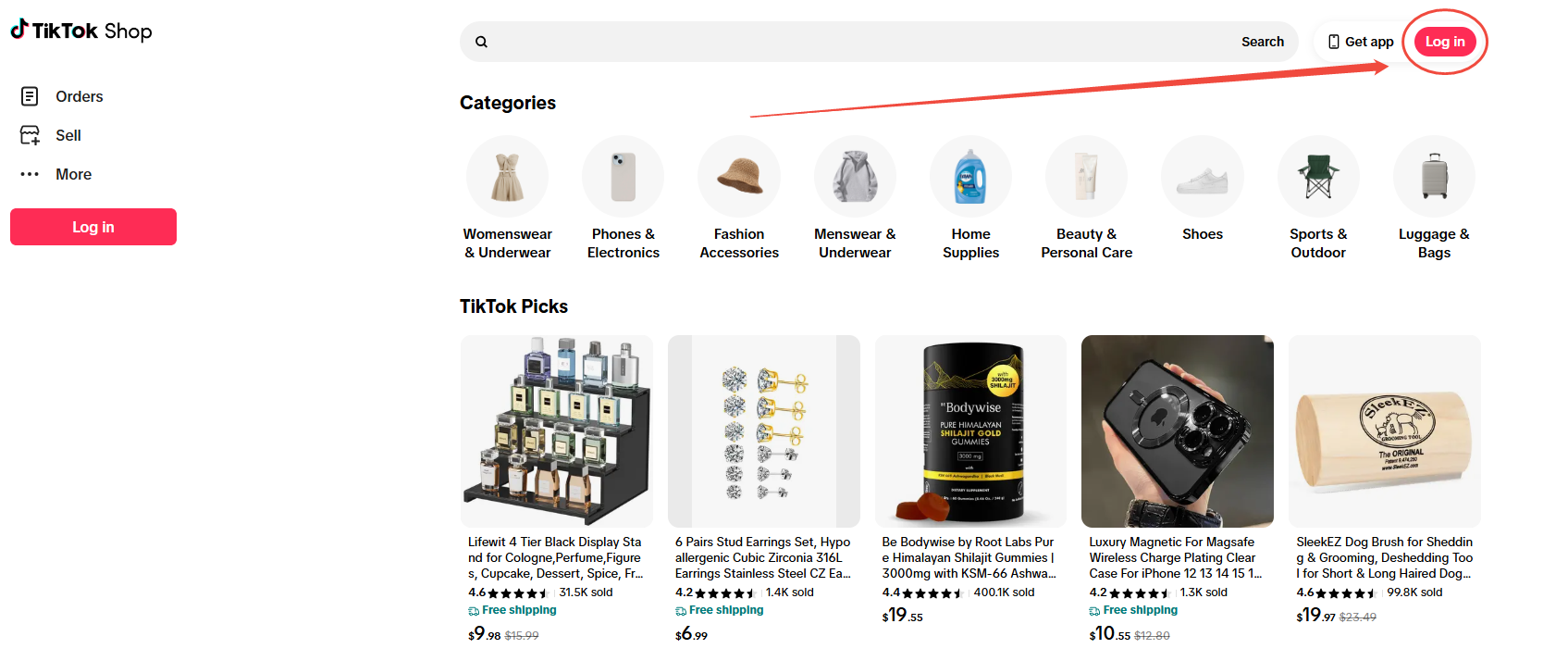
1. Prepare creatives
-
Produce short (6–15s) vertical videos: product-in-action shots, before/after demos, unboxing, and “why you need this for fall.” Use trending audio and fast captions.
-
For each bestseller produce 3 variations: demo, reaction (real people), and lifestyle (cozy fall setting).
2. TikTok Shop integration (if applicable)
-
Apply to TikTok Shop; connect your store/catalog. CJdropshipping can fulfill TikTok Shop orders if you configure the flow (order funnels vary by country).
-
For TikTok Shop, ensure CJ can ship direct to buyer and provide tracking that fits TikTok’s delivery expectations.
3. Content→Shop workflow
-
Add product links (deep links) to your bio and video descriptions that point to the product page. Use a UTM system to track which creatives convert best.
-
Include strong CTAs: “Limited fall stock,” “Ships in 3–7 days from US,” or “Use code FALL10.”
4. Live commerce
-
Test TikTok Live product demos. During live sessions, push standardized discount codes and limited-time bundles. Have CJ’s stock details handy to avoid overselling.
5. Order management
-
For TikTok-driven orders to your Shopify store, standard CJ auto-fulfillment applies. Map TikTok order notes to Shopify orders for tracking.
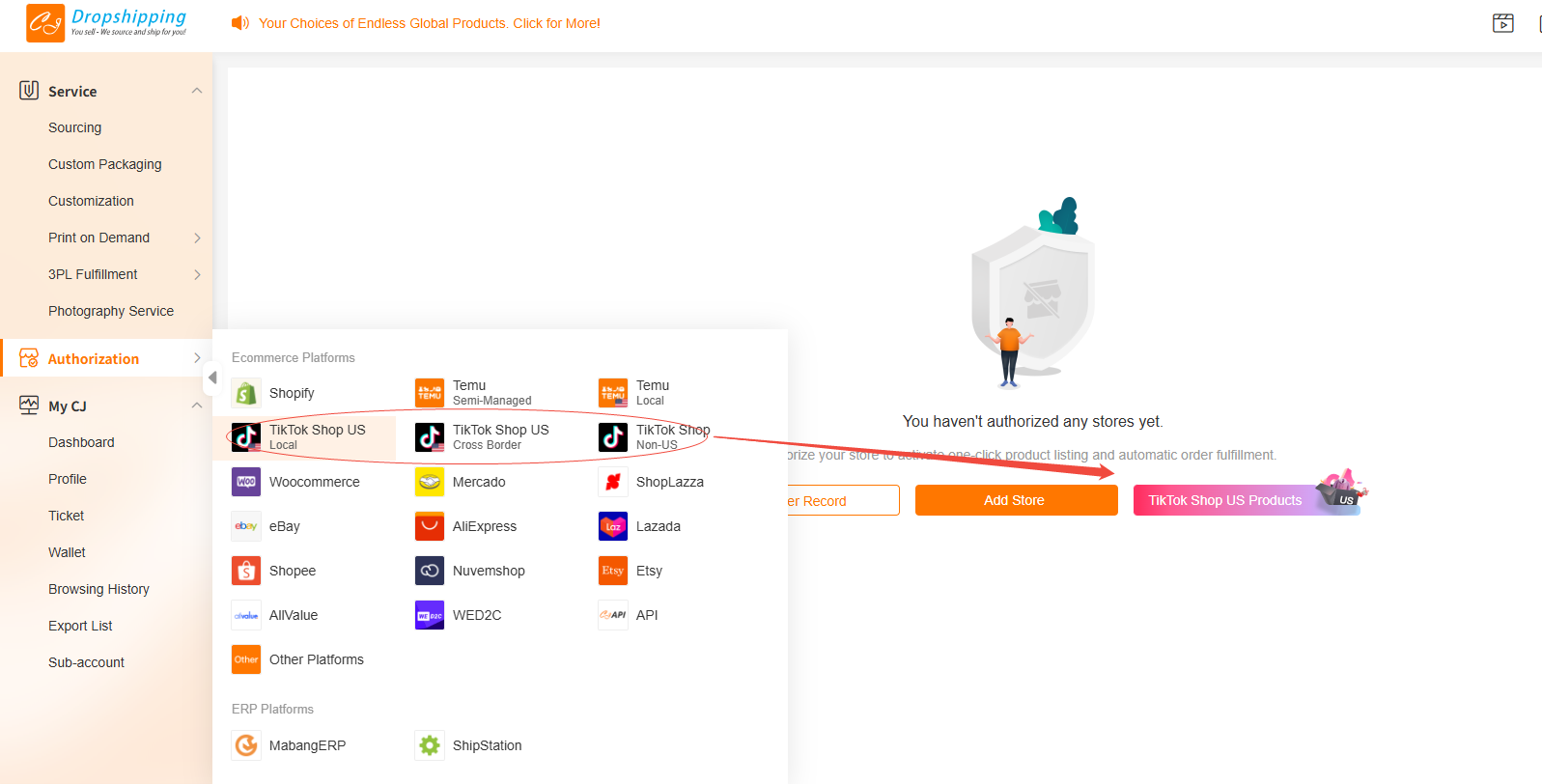
D. Amazon (FBM) + CJdropshipping — careful, compliance required
Amazon can be lucrative but has strict dropshipping rules. Use caution.
Important compliance rules (summary)
-
You must be the seller of record. The packing slip, invoice, or external packaging must identify you as the seller.
-
You must accept returns and be responsible for customer service.
-
Shipping that hides or lists supplier info on package can get your account suspended.
Recommended path (safe method)
-
Fulfilled by Merchant (FBM) — you list on Amazon and fulfill using CJ but ensure packaging shows your seller name. Ask CJ about white-label packaging and inserting your invoice.
-
Use Amazon’s dropshipping policy carefully — never ship items with supplier invoices or branding visible to customers.
Step-by-step
-
Register Professional Seller account (if you plan higher volume).
-
Create product listings with Amazon-optimized titles and bullet points. Use EAN/UPC or apply for GTIN exemption if private labeling.
-
For each Amazon order, place the order via CJ with your buyer’s shipping address. Request CJ to omit supplier info and include your store branding on the invoice/packing slip. (Confirm with CJ before using lower-cost China stock.)
-
Upload tracking number to Amazon within the required window.
-
Monitor returns and have a protocol with CJ to either restock returns or accept returns to your address.
Caveats & safer alternatives
-
If CJ cannot guarantee white-label packaging, avoid Amazon and focus on Shopify/WooCommerce/TikTok. Amazon suspension risk is real if policy is violated.
-
Consider building Amazon presence via private label – buy inventory and send to FBA, or negotiate CJ to fulfill white-label bulk inventory to you first.
Platform-agnostic CJdropshipping best practices
-
Local warehouses first — prioritize CJ US/EU stock for fall to guarantee delivery windows.
-
Sample everything — check product build, packaging, and brandability.
-
Enable tracking — ensure CJ pushes tracking to the platform automatically. Customers expect tracking for fall purchases.
-
Branded packaging — order a small run of branded boxes/inserts for your top SKUs to increase perceived value.
-
Backup suppliers — always list a secondary supplier SKU for each product in case of stockouts.
-
Returns process — predefine return address (your RMA or CJ options) and clarify who pays return shipping. Display return policy on product pages.
-
Inventory alerts — set low-stock alerts in CJ and platform dashboards; pause ads if stock drops below safe threshold.
FAQ for Best Dropshipping Products(2025.9)
Q: How can I find which products will be hot this fall?
A: Use Google Trends, TikTok/Instagram signals, industry reports (CJdropshipping, SaleHoo), and competitor ad libraries to spot rising searches.
Q: When should I start promoting fall products?
A: Begin in late August/early September; run pre-season tests to optimize ads, inventory, and autumn-themed store visuals before peak season.
Q: How should I test ads for these seasonal products?
A: Split-test creatives and audiences with small budgets; use short videos, UGC style, autumn imagery, then scale winning ads quickly.
Q: How do I handle shipping and logistics during seasonal rushes?
A: Plan for delays, use local warehouses, secure backup suppliers, offer expedited options, and communicate realistic delivery estimates to customers.
Q: What profit margins can I expect on these niche products?
A: Margins vary 30–100% by product; target >50% gross where possible and always factor in shipping plus ad costs.
Q: Should I change my store’s theme or marketing for fall?
A: Yes. Update banners, colors, and categories to autumn themes; run seasonal bundles and Halloween campaigns to boost conversions.
